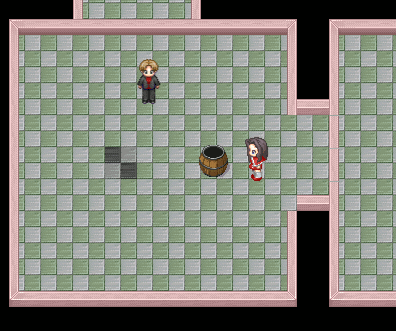This is part of a series for the Out of Phase game project that reflects on various stages, covering pros and cons of the creative process and implementation of the game. The first post can be found here.
Deciding what type of game you’re creating can be difficult while the concept is in its infancy. There’s so many ideas you want to use, and many of those may conflict with each other at first, requiring some compromise in order for them to gel
In Out of Phase, there was a struggle to combine puzzle and action mechanics.I was trying to integrate elements from the two genres that I knew were successful by themselves, but incompatible with each other. To resolve this, I had to consider what experience I wanted to give the player and how the mechanics from each genre would contribute to that experience.
Some ideas I had to let go of, as they were too far from the vision, and other ideas had to be reworked to fit the core game concept. Here’s a reflection of that journey.
Puzzles
First I’ll start off with what kind of puzzler this is not, but what I originally thought it was going to be.
Some of my favorite games are point-and-click puzzlers, such as Myst or Escape the Room games such as Crimson Room. In these types of games, the player can progress at their leisure. While there may be action sequences, they usually don’t require interaction from the player, though there are some exceptions where the player must make a timed decision during the action sequence. The timing is typically pretty lax however.
Games like Myst, Crimson Room, or even The 7th Guest are what I would consider leisure puzzlers. They are typically slower paced compared to an action game and focus more on immersion and an experience. Death in these games are pretty rare, and are based off of a decision and not action, so the player is given a high level of safety while exploring the worlds. The focus of these games is on immersing the player into a fantasy world, and death or abrupt twitch mechanics tend to draw the player out.
While these games are fun, they weren’t the style I was looking for. Instead, I wanted to go with something more real time and physical, like Maniac Mansion or the more recent Ib. I wanted to give the player a different feeling of tension that they may need to react fast to avoid getting injured or killed, which deviated from leisure puzzlers.
This was a point of conflict in my early design brainstorming, because I liked the pacing and immersion of the leisure puzzlers. However, every time I tried to settle on removing action from the game, it felt incomplete. So I moved onto a different type of puzzler, one which was more physical and time sensitive.
In the first prototype I started with a very basic series of chambers and hallways that contain puzzles. This is what was implemented at the the Global Game Jam, and I had the beginnings of what was like a Portal clone, with pressure plates and objects that could be pushed onto them.
Where it differed from Portal (besides no portals!) is some objects and parts of the maps would be different between the players, in some cases requiring the players to communicate and discover the difference in order to complete the puzzle.
There would be furnished rooms with interactive objects, like a record player that would play music, light switches, and paintings. The player would need to interact with certain objects and in some cases complete a sequence in order to progress through the game.
With these ideas, this game was becoming more like Ib, where core gameplay involved adventuring through the levels and discovery. There would be some action sequences, but the player had to evade dangers, opposed to attacking those dangers.
The game concept already sounded fun, and there were so many possibilities for puzzles. Yet, there were some things that didn’t feel right. I didn’t want the player to be totally defenseless, I wanted to let them fight back. I also needed something that gave the game some replay value after the puzzles were figured out, so my focus began to shift.

